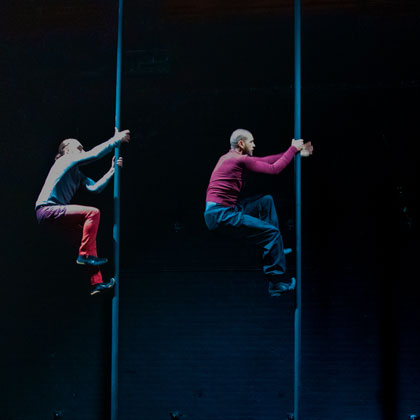Review from: Jacksons Lane, London International Mime Festival; 5th February, 2022
I’ll admit: my favourite kind of shows, circus or otherwise, are brave shows. Shows that dare deal with themes one does not frequently see on stage, shows that take the risk of offending or upsetting or just challenging audiences to have more than an entertaining night at the theatre.
The Chosen Haram is brave from its very first moment. As the audience enter, we see two Chinese poles set up on stage. one holds a body wrapped tightly in plastic, looking like something between a crime scene cadaver and a blow-up, sex doll gimp. From it, like a butterfly from a cocoon, will later emerge Sadiq Ali, the auteur behind The Chosen Haram. On the other pole there’s a pile of clothes which, we will later discover, holds the other performer (Hauk Pattison) within its folds.
Throughout the show it is never quite clear whether the two performers are two separate characters or indeed two facets of the same person. Perhaps they are both. Perhaps it doesn’t matter. What matters is the energy between them, buzzing and disturbing and nurturing and seductive and comforting. They hold space for each other to be vulnerable at times, and push each other to experiment and dare at others. Sometimes they cannot exist without the other, and sometimes they are toxic to one another.
“Haram” is an Islamic term that means “forbidden”. Throughout the show the two performers engage in acts that could be interpreted as forbidden — sex, drugs, alcohol, excessive partying — and the question of choice always hovers in the air. If one chooses to engage in the forbidden, the show asks over and over again, what implications could that bring about?
The ghost of Islam pokes its head frequently. In one of the earlier moments in the show, a rectangular light projected on the floor evokes the image of an Islamic prayer mat, over which Ali kneels and prays. Later, when the two characters (or two sides of the same character, or both) are in a club, Pattison invites Ali to join him in the debauchery. Ali is about to do so when that rectangular light comes back — is it just another light in the club, or is it Ali’s struggles with his faith that remind him of what’s allowed and what’s Haram?
Ali and Pattison spend a lot of time playing with their poles (phallic entendre?) together and apart. A mesmerising moment occurs when Pattison wraps shrink-wrap around both poles, creating a narrow and tight space for himself to crawl into, where he writhes and contorts, gasping for breath, accompanied by psychedelic lights and beats. When Ali transcends his pole and the Call to Prayer sounds, he bows to his pole in the same way he bowed on the prayer mat. It was a beautiful moment that made me question the things we hold holy and our relationship to them; circus artists have such an intimate relationship with their equipment, spending an obscene amount of hours working with it, exploring it, being beaten by it and learning how to tame it… Maybe it’s not so much unlike our relationship to faith or sexuality. Sometimes we worship it, sometimes it humbles us, sometimes we delight in it.
But maybe the most tender of moments is when both of them dance together with the poles, in a pas-de-deux that I can only best describe as two people searching — for joy, for understanding, for compassion, for each other. When they share a pole they dance around each other, making spaces where it seems impossible to make spaces, jumping over each, wrapping and dropping and playing. When they take to both poles their dance becomes synchronised, their moves mirroring each other’s, working together and exuding utter joy.
The Chosen Haram is brave because it asks us to look at who we are and what we want, in relation to all the barriers, rules and boundaries we were told we must abide by. It brings together some of the most complex aspects of our identities, both individual and societal — sexuality, religion, addiction — and does so with an equal amount of entertainment and profoundness. It is a courageous, skilled, unabashed work of queer-storytelling, done with meticulous precision and an innovative approach.



